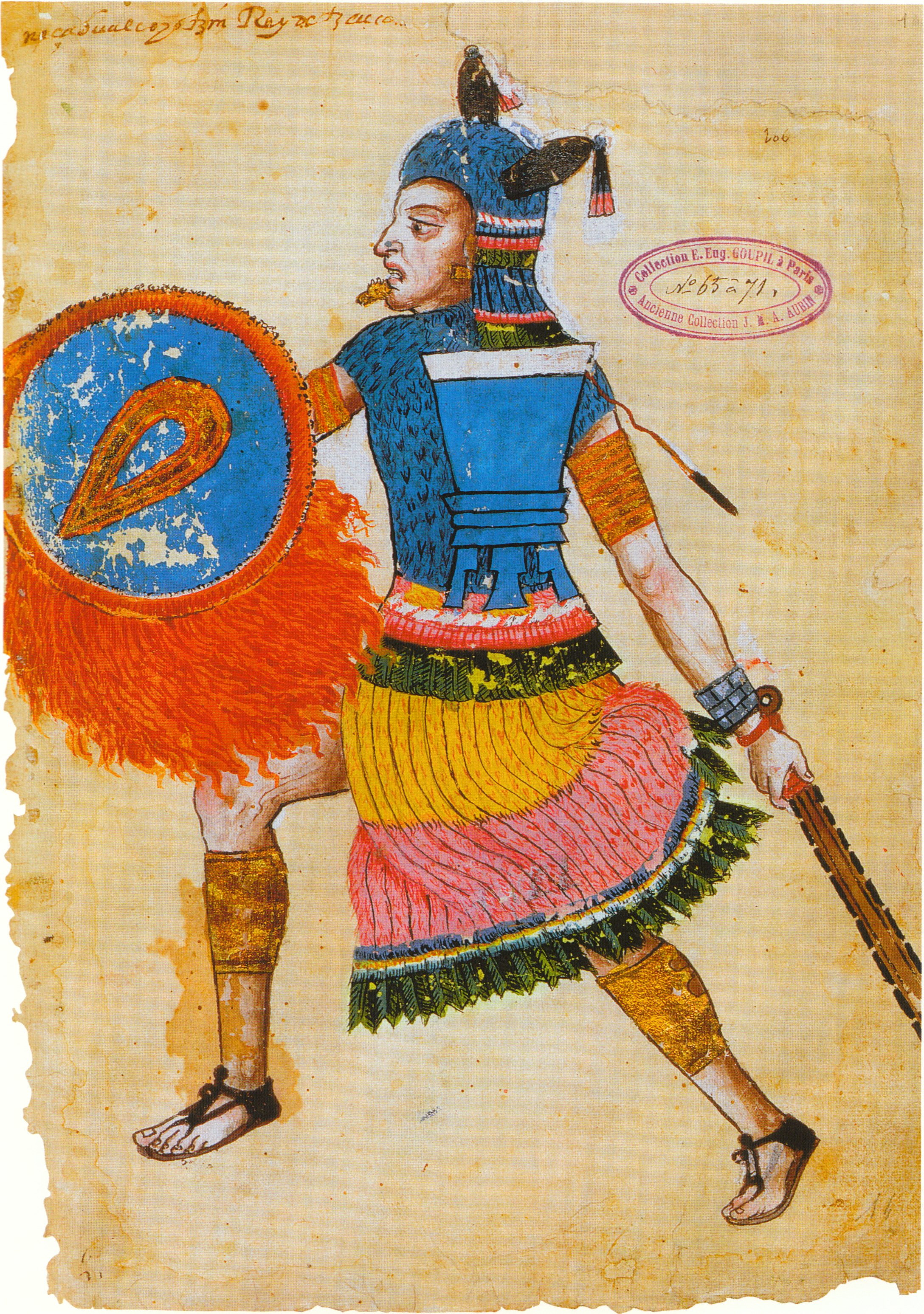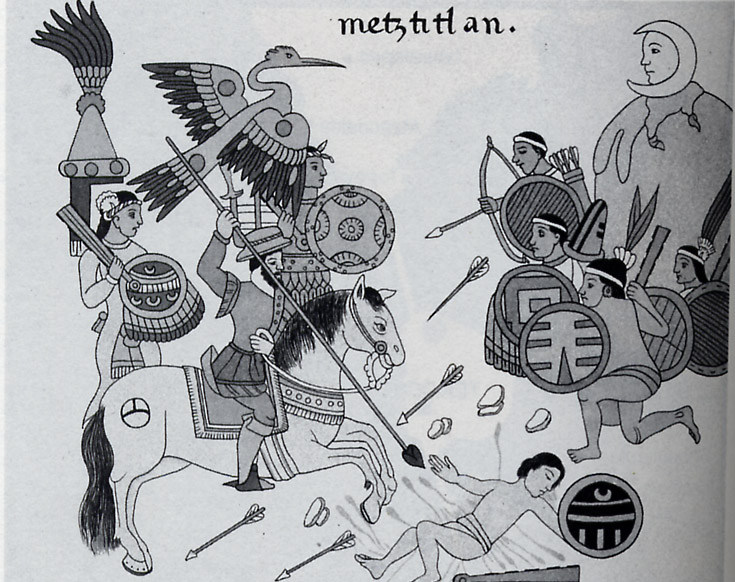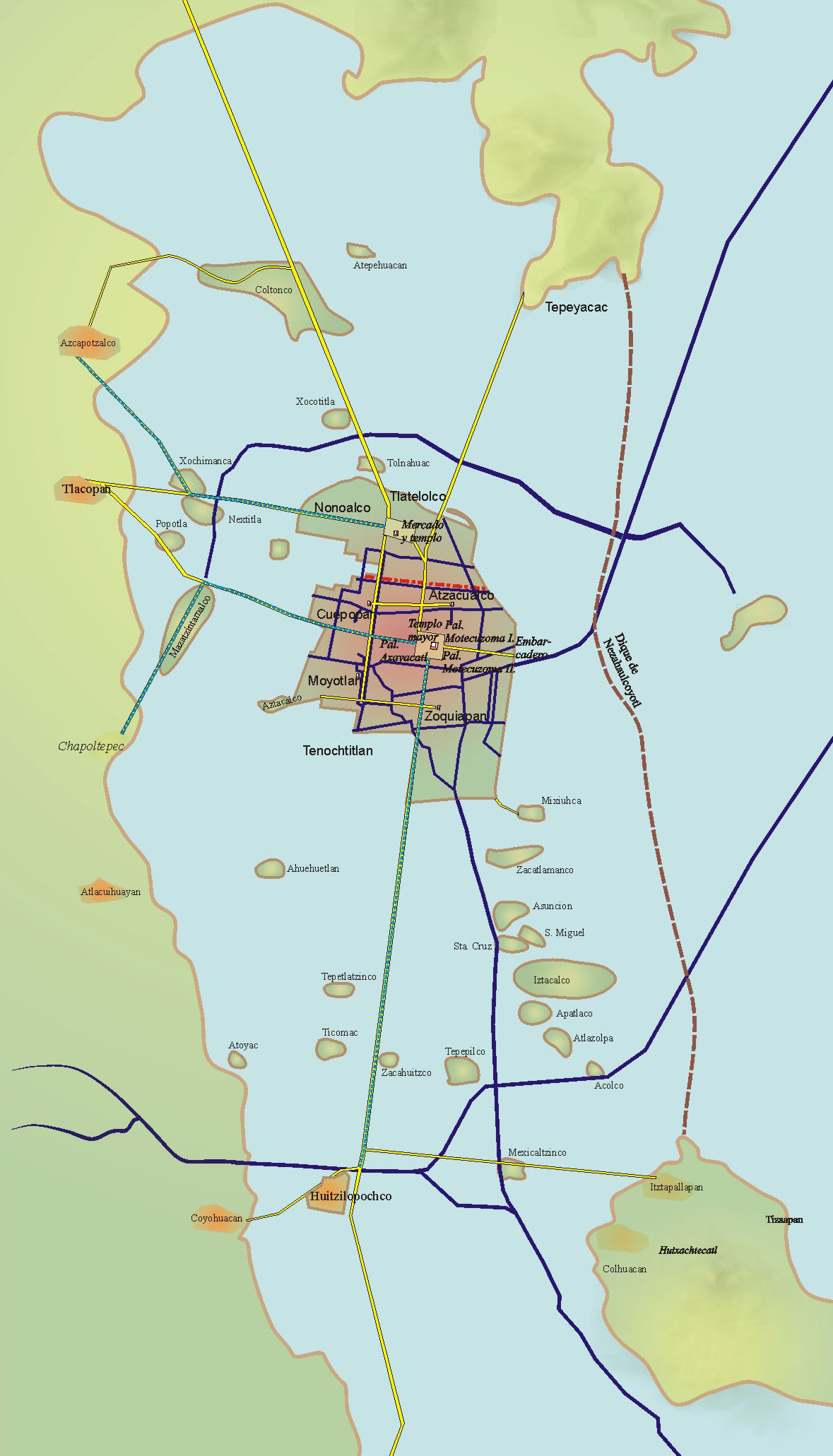|
Xicotencatl The Younger
Xicotencatl II Axayacatl, also known as Xicotencatl the Younger (died 1521), was a prince and warleader, probably with the title of '' Tlacochcalcatl'', of the pre-Columbian state of Tlaxcala at the time of the Spanish conquest of the Aztec Empire. Biography An ethnic Tlaxcaltec, Xicotencatl the Younger was the son of the ruler of Tizatlan, one of the four confederate altepemeh of the Tlaxcallan state, of which he was considered to be the ''de facto'' ruler because of his father's weakened health. His Nahuatl name, pronounced , is sometimes also spelled Xīcohtēncatl and means "person from Xīcotēnco," a place name that can be translated "at the edge of the bumblebees." He is known primarily as the leader of the force that was dispatched from Tlaxcallan to intercept the forces of Hernán Cortés and his Totonac allies as they entered Tlaxcallan territory when going inland from the Veracruz coast. His actions are described in the letters of Cortés, Bernal Díaz del Castill ... [...More Info...] [...Related Items...] OR: [Wikipedia] [Google] [Baidu] |
Regent
In a monarchy, a regent () is a person appointed to govern a state because the actual monarch is a minor, absent, incapacitated or unable to discharge their powers and duties, or the throne is vacant and a new monarch has not yet been determined. The rule of a regent or regents is called a regency. A regent or regency council may be formed ''ad hoc'' or in accordance with a constitutional rule. ''Regent'' is sometimes a formal title granted to a monarch's most trusted advisor or personal assistant. If the regent is holding the position due to their being in the line of succession, the compound term '' prince regent'' is often used; if the regent of a minor is their mother, and she is wife or widow of the king, she would be referred to as ''queen regent''. If the formally appointed regent is unavailable or cannot serve on a temporary basis, a may be appointed to fill the gap. In a monarchy, a regent usually governs due to one of these reasons, but may also be elected to ... [...More Info...] [...Related Items...] OR: [Wikipedia] [Google] [Baidu] |
Diego Muñoz Camargo
Diego Muñoz Camargo ( – 1599) was the author of '' History of Tlaxcala'', an illustrated codex that highlights the religious, cultural, and military history of the Tlaxcalan people. Life Diego Muñoz Camargo was born in Spanish colonial Mexico of a Spanish father and Indian mother. He acted as official interpreter for the Spanish, particularly the Franciscans The Franciscans are a group of related organizations in the Catholic Church, founded or inspired by the Italian saint Francis of Assisi. They include three independent religious orders for men (the Order of Friars Minor being the largest conte .... He was also a chronicler of some note, belonging to a group of mestizo chroniclers with Fernando de Alva Cortés Ixtlilxóchitl and Fernando Alvarado Tezozómoc. His ''History of Tlaxcala'', one version of a work of various forms, stands as an important source for Tlaxcala, in Mexico. Muñoz Camargo was a businessman who entered into lucrative cross-cultural enterpri ... [...More Info...] [...Related Items...] OR: [Wikipedia] [Google] [Baidu] |
Alfredo Chavero
Alfredo Chavero (1841–1906) was a Mexican archaeologist, politician, poet, and dramatist. According to Howard F. Cline, "Chavero's most enduring claim to remembrance rests...on iscompletion and extension of Ramírez's plans to republish major native histories and his editorship of pictorial documents." Research Chavero conducted numerous investigations on Mexican antiquities. He published ''Historia Antigua de Mexico'', as well as several works on Aztec archaeology, especially on ancient monuments. While excavating the pyramids of Cholula, he discovered some idols that are now in the National Museum of Mexico. His books are often referred to because of his research on Father Sahagún and to the Sun Stone. . Political career Chavero became a member of the Mexican Congress in 1869. He supported the Mexican presidents Benito Juárez, Sebastián Lerdo de Tejada, Manuel González, and Porfirio Díaz in succession, notwithstanding their different policies. On 25 June 18 ... [...More Info...] [...Related Items...] OR: [Wikipedia] [Google] [Baidu] |
Universidad Nacional Autónoma De México
The National Autonomous University of Mexico (, UNAM) is a public university, public research university in Mexico. It has several campuses in Mexico City, and many others in various locations across Mexico, as well as a presence in nine countries. It also has 34 research institutes, 26 museums, and 18 historic sites. A portion of (University City), UNAM's main campus in Mexico City, is a UNESCO World Heritage site that was designed and decorated by some of Mexico's best-known architects and painters. The campus hosted the main events of the 1968 Summer Olympics, and was the birthplace of the Mexican Movement of 1968, student movement of 1968. All Mexican Nobel laureates have been alumni of UNAM. In 2009, the university was awarded the Princess of Asturias Awards, Prince of Asturias Award for Communication and Humanities. More than 25% of the total scientific papers published by Mexican academics come from researchers at UNAM. UNAM was founded in its modern form, on 22 Septemb ... [...More Info...] [...Related Items...] OR: [Wikipedia] [Google] [Baidu] |
Xicotencatl The Elder
Xicotencatl I or Xicotencatl the Elder (c. 11 House (1425) – c. 4 Rabbit (1522)) was a long-lived '' teuctli'' (elected official) of Tizatlan, a Nahua ''altepetl'' (city-state) within the Confederacy of Tlaxcala, in what is now Mexico. He was instrumental in allying the Tlaxcaltecs with the Spanish to overthrow the Aztec Empire, after which he converted to Christianity under the name of Lorenzo Xicotencatl or Don Lorenzo de Vargas. Etymology His Nahuatl name, pronounced , is sometimes spelled Xicohtencatl. Early life At the time of the Spanish conquest of the Aztec Empire he was very old and of poor health. He was instrumental in aligning the Tlaxcala with Hernán Cortés' Spaniards.Diaz, B., 1963, The Conquest of New Spain, London: Penguin Books, Tlaxcalan historian Diego Muñoz Camargo wrote of him that he was more than 120 years old and that he could only see Cortés if he had someone lift his eyelids for him. He also writes that he had more than 500 wives and concu ... [...More Info...] [...Related Items...] OR: [Wikipedia] [Google] [Baidu] |
Ross Hassig
Ross Hassig (born December 13, 1945) is an American historical anthropologist specializing in Mesoamerican studies, particularly the Aztec culture. His focus is often on the description of practical infrastructure in Mesoamerican societies. He is the author of several influential books, among them: ''Time, History, and Belief in Aztec and Colonial Mexico''; ''Aztec Warfare: Imperial Expansion and Political Control''; and ''Trade, Tribute, and Transportation: The Sixteenth-Century Political Economy of the Valley of Mexico''. Career Hassig began his academic career as an undergraduate at Vanderbilt University, where his studies initially focused on non-Western legal systems. He soon developed an interest in anthropology, later obtaining in 1974 his Master's degree from Vanderbilt in Law and Anthropology, with a thesis on political development among the Puebloan peoples at Acoma Pueblo. He then went on further his graduate studies at Stanford University, obtaining his Ph.D. from the D ... [...More Info...] [...Related Items...] OR: [Wikipedia] [Google] [Baidu] |
History Of Tlaxcala
''History of Tlaxcala'' (Spanish: ''Historia de Tlaxcala'') is an alphabetic text in Spanish with illustrations written by and under the supervision of Diego Muñoz Camargo in the years leading up to 1585. Muñoz Camargo's work is divided into three sections: *''"Relaciones Geográficas"'' or ''"Descripción de la ciudad y provincia de Tlaxcala"'', a Spanish text written by Camargo between 1581 and 1584 in response to Philip II of Spain's ''Relaciones Geográfica'' questionnaire. *The "Tlaxcala Calendar", a largely pictorial section, with both Spanish and Nahuatl captions. *The "Tlaxcala Codex" a largely pictorial section, with both Spanish and Nahuatl captions. Another key source for Tlaxcalan history is the '' Lienzo de Tlaxcala'', a colonial-era pictorial codex, produced in the second half of the sixteenth century. It was created at the request of the cabildo of the city of Tlaxcala. According to the information that is known about the document, three copies were produced, o ... [...More Info...] [...Related Items...] OR: [Wikipedia] [Google] [Baidu] |
Texcoco (altepetl)
Tetzcoco (Classical Nahuatl: ''Tetzco(h)co'' , Otomi: ) was a major Acolhua altepetl (city-state) in the central Mexican plateau region of Mesoamerica during the Late Postclassic period of pre-Columbian Mesoamerican chronology. It was situated on the eastern bank of Lake Texcoco in the Valley of Mexico, to the northeast of the Aztec capital, Tenochtitlan. The site of pre-Columbian Tetzcoco is now subsumed by the modern Mexican ''municipio'' of Texcoco and its major settlement, the city formally known as Texcoco de Mora. It also lies within the greater metropolitan area of Mexico City. Pre-Columbian Tetzcoco is most noted for its membership in the Aztec Triple Alliance. At the time of the Spanish conquest of the Aztec Empire, it was one of the largest and most prestigious cities in central Mexico, second only to the Aztec capital, Tenochtitlan. A survey of Mesoamerican cities estimated that pre-conquest Tetzcoco had a population of 24,000+ and occupied an area of 450 h ... [...More Info...] [...Related Items...] OR: [Wikipedia] [Google] [Baidu] |
Siege Of Tenochtitlan
The fall of Tenochtitlan, the capital of the Aztec Empire, was an important event in the Spanish conquest of the empire. It occurred in 1521 following extensive negotiations between local factions and Spanish conquistador Hernán Cortés. He was aided by La Malinche, his interpreter and companion, and by thousands of indigenous allies, especially Tlaxcaltec warriors. Although numerous battles were fought between the Aztec Empire and the Spanish-led coalition, which was composed mainly of Tlaxcaltec men, it was the siege of Tenochtitlan that directly led to the fall of the Aztec civilization and the ensuing sacking and violence against the survivors. The indigenous population at the time was devastated due to a smallpox epidemic, which killed much of its leadership. Because smallpox had been endemic in Spain for centuries, the Spanish had developed an acquired immunity and were affected relatively little in the epidemic. The conquest of the Aztec Empire was a critical s ... [...More Info...] [...Related Items...] OR: [Wikipedia] [Google] [Baidu] |
Aztec
The Aztecs ( ) were a Mesoamerican civilization that flourished in central Mexico in the Post-Classic stage, post-classic period from 1300 to 1521. The Aztec people included different Indigenous peoples of Mexico, ethnic groups of central Mexico, particularly those groups who spoke the Nahuatl, Nahuatl language and who dominated large parts of Mesoamerica from the 14th to the 16th centuries. Aztec culture was organized into city-states (''altepetl''), some of which joined to form alliances, political confederations, or empires. The Aztec Empire was a confederation of three city-states established in 1427: Tenochtitlan, the capital city of the Mexica or Tenochca, Tetzcoco (altepetl), Tetzcoco, and Tlacopan, previously part of the Tepanec empire, whose dominant power was Azcapotzalco (altepetl), Azcapotzalco. Although the term Aztecs is often narrowly restricted to the Mexica of Tenochtitlan, it is also broadly used to refer to Nahuas, Nahua polities or peoples of central Pre ... [...More Info...] [...Related Items...] OR: [Wikipedia] [Google] [Baidu] |
La Noche Triste
La Noche Triste ("The Night of Sorrows", literally "The Sad Night"), was an important event during the Spanish conquest of the Aztec Empire, wherein Hernán Cortés, his army of Spanish conquistadors, and their native allies were driven out of the Aztec capital, Tenochtitlan. Prologue Cortés' expedition arrived at Tenochtitlan on November 8, 1519, taking up residence in a specially designated compound in the city. Soon thereafter, suspecting treachery on the part of their hosts, the Spaniards took Moctezuma II, the Aztec king or ''Tlatoani'', hostage. Though Moctezuma followed Cortés' instructions in continually assuring his subjects that he had been ordered by the gods to move in with the Spaniards and that he had done so willingly, the Aztecs suspected otherwise. During the following 98 days, Cortés and his native allies, the Tlaxcaltecs, were increasingly unwelcome guests in the capital. Cortés heads off Spanish punitive expedition In May 1520, news from the Gulf coast r ... [...More Info...] [...Related Items...] OR: [Wikipedia] [Google] [Baidu] |





